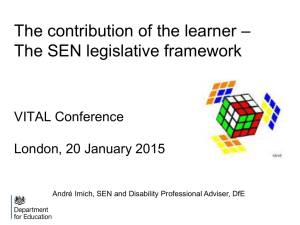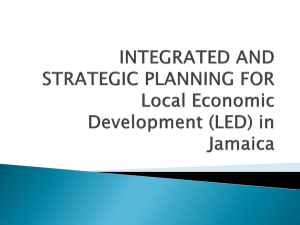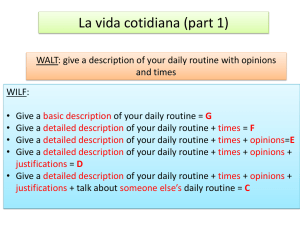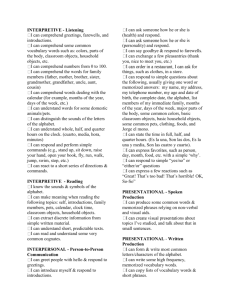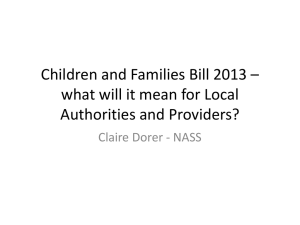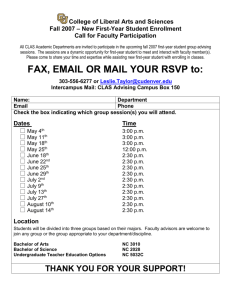The climate of inclusive classrooms: The student perspective
advertisement
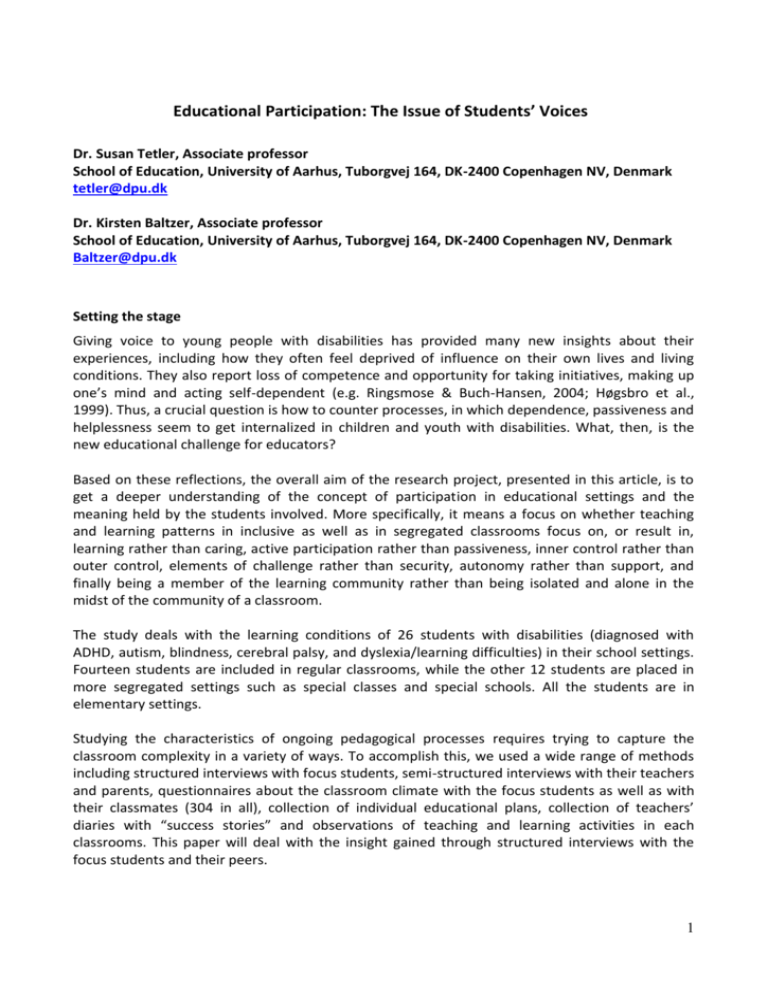
Educational Participation: The Issue of Students’ Voices Dr. Susan Tetler, Associate professor School of Education, University of Aarhus, Tuborgvej 164, DK-2400 Copenhagen NV, Denmark tetler@dpu.dk Dr. Kirsten Baltzer, Associate professor School of Education, University of Aarhus, Tuborgvej 164, DK-2400 Copenhagen NV, Denmark Baltzer@dpu.dk Setting the stage Giving voice to young people with disabilities has provided many new insights about their experiences, including how they often feel deprived of influence on their own lives and living conditions. They also report loss of competence and opportunity for taking initiatives, making up one’s mind and acting self-dependent (e.g. Ringsmose & Buch-Hansen, 2004; Høgsbro et al., 1999). Thus, a crucial question is how to counter processes, in which dependence, passiveness and helplessness seem to get internalized in children and youth with disabilities. What, then, is the new educational challenge for educators? Based on these reflections, the overall aim of the research project, presented in this article, is to get a deeper understanding of the concept of participation in educational settings and the meaning held by the students involved. More specifically, it means a focus on whether teaching and learning patterns in inclusive as well as in segregated classrooms focus on, or result in, learning rather than caring, active participation rather than passiveness, inner control rather than outer control, elements of challenge rather than security, autonomy rather than support, and finally being a member of the learning community rather than being isolated and alone in the midst of the community of a classroom. The study deals with the learning conditions of 26 students with disabilities (diagnosed with ADHD, autism, blindness, cerebral palsy, and dyslexia/learning difficulties) in their school settings. Fourteen students are included in regular classrooms, while the other 12 students are placed in more segregated settings such as special classes and special schools. All the students are in elementary settings. Studying the characteristics of ongoing pedagogical processes requires trying to capture the classroom complexity in a variety of ways. To accomplish this, we used a wide range of methods including structured interviews with focus students, semi-structured interviews with their teachers and parents, questionnaires about the classroom climate with the focus students as well as with their classmates (304 in all), collection of individual educational plans, collection of teachers’ diaries with “success stories” and observations of teaching and learning activities in each classrooms. This paper will deal with the insight gained through structured interviews with the focus students and their peers. 1 Research on students’ perspectives on learning In the research field of special education, we see a lack of research projects, taking the student perspective seriously. Gaining more substantial knowledge about increased problems in schools with disengagement, marginalisation and school failure, we need to ask students at risk, how they perceive their role in schools, and what they experience as characteristics of their learning environment. Dealing effectively with that kind of problems, we need to understand their motives and incentives. Mitchell’s definition of learning environment has three dimensions (Mitchell, 2008): 1) Relationships (the extent to which people in the classroom support and help each other). 2) Personal development (the extent to which personal growth and self-enhancement is facilitated). 3) System maintenance (the extent to which the classroom is orderly, end educators are clear in their expectations, maintain control and are responsive to change). Mitchell finds that learning environment and classroom climate depict nearly the same factors related to learning in schools, and this view is supported by a review from Danish Clearinghouse for Educational Research (Nordenbo et al., 2008). This review defines classroom climate as a construct including three indicators: 1) Student activity (the extent to which students are involved in decisions about classroom activities) and motivation (especially self- or inner motivation), 2) supportive behaviour (the extent to which the teacher involves students in structuring the learning situation and supportive collaboration), and 3) Student/Teacher relationship (the extent to which the teacher is supportive in relation to student initiatives and motivation). The wording is slightly different from Mitchell’s, but the content is in fact overlapping. Bronfenbrenner (1986) focuses on the relation between the learning context and acquisition of personal competences. A learning context is characterized by situational requirements and demands, and development of competence is a result of the interaction between the context and personal attributes (Wentzel, 2006). These are cognitive and self-monitoring and self-regulating skills as well as personal goals and values. Student experiences are primarily influenced by proximal processes as relations, communication, and interactions (Bronfenbrenner, 1999), and positive experiences are related to the quality of proximal processes. Bronfenbrenner define these processes as proximal, but they need further elaboration to serve as constructs for operationalization into research tools. The lesson learnt from Bronfenbrenner’s research tools should include indicators related to the learning context in a broader perspective, learning situations, social relationships between the teacher and student as well as among students, communication and interaction from the interpersonal as from the intrapersonal perspective. Mitchell’s and Nordenbo’s meta-reviews give hints to how to transform Bronfenbrenner’s concept of proximal processes into research tools. Other sources of inspiration emerge from theories and studies about inclusion and participation in educational settings. The theoretical reviews presented in Almquist, Eriksson & Granlund (2004) and Allodi (2007) depict the importance of students’ personal experiences on the learning environment and learning outcomes, and these reviews are in line with Bronfenbrenner and 2 Nordenbo. However, Nordenbo (2008) mentions the issue of the German traditions with focus on ‘Bildung’, when conducting meta-reviews on classroom management, following the guidelines presented in The Clearing House concept (2006). According to the German tradition, education is rooted in philosophy, and this tradition has been very influential in the Nordic countries including Denmark. Nordenbo argues that the ethics and morality included in the philosophical position on ‘Bildung’ and didactics is indeed a necessary perspective. Within this tradition there has been no focus on the consequences for management of the teaching and learning processes, and it is nearly impossible to find studies fulfilling the criteria for inclusion in a Clearing House review. The same criticism is relevant concerning Mittchell’s meta-review. This criticism has to be considered when creating research tool based on Bronfenbrenner’s position. In other words, the tool has to reflect the Danish learning context inspired from both the German tradition for centuries as well as for the International tradition mainly rooted in Anglo-American traditions and studies, which is an upcoming inspiration. As a consequence it was necessary for us to seek inspiration from another meta-review conducted within a German context. The German researcher in didactics Hilbert Meyer (2005) has done a meta-review on good teaching. He finds ten characteristics of good teaching, which include more details about the structure of the teaching process, communication and differentiation. But of course there are similarities to the studies already mentioned. Allodi (2007) has prepared and tested a theory-based instrument for assessing the quality of learning environments in Swedish schools. This instrument is based on a concept of learning environment and classroom climate, which our study is committed to. The instrument is designed as a questionnaire: The Goals, Attitudes, and Values in School (GAVIS). GAVIS is adapted to students in lower and upper secondary school in Sweden. Based on the theoretical and empirical analyses, Allodi argues for a model of learning environments with ten factors organised in a pattern with three higher-order factors. Allodi argues (2007, p. 172): I suggest calling the first higher-order factor Self-expression (including Influence, Creativity, Stimulation), the second Self-affirmation (including Achievement, Efficacy and Safety), and the third Sociality (including Control, Helpfulness, Participation and Responsibility). The covariance matrix between the higher-order factors suggests that they are equidistant but, rather, that Self-Affirmation seems to take a more central position. There are many similarities between Mitchell’s definition based on a meta-review and Allodi’s theory-based empirical model evaluated form a holistic perspective. However, the higher-order factors (Allodi) and the main factors (Mitchell) combine the lower order factors into different patterns. They fit into Bronfenbrenner’s views as well. Allodi stresses that Self-affirmation (including Achievement, Efficacy and Safety) has a central position in evaluation of the quality of learning environment. Self-Affirmation has an interpersonal as well as an intrapersonal dimension. The operationalization of Allodi’s model from factors into items reveals that the assessment focuses on the interpersonal dimension. Understanding a person’s self-affirmation, however, includes both dimensions. 3 Hence, is has been necessary to expand the theoretical perspectives. The concept ‘efficacy’ is rooted in Bandura’s social learning theory. According to Bandura (1994) ‘Perceived self-efficacy is defined as people’s beliefs about their capabilities to produce designated levels of performance that exercise influence over events that affect their lives. Self-efficacy beliefs determine how people feel, think, motivate themselves and behave’ (1994, p 71). A strong sense of self-efficacy is a major motivational factor, in school settings as in other settings, where people conduct their lives. There are four main sources to a strong sense of efficacy: Mastery experiences, vicarious experiences provided by social models, social persuasion, and somatic and emotional states. It has to be mentioned that social persuasion is verbal persuasion and includes competence to structure situations - for oneself as for other people - in ways bringing success. Part of this competence is to avoid situations or challenges where people are likely to fail. Bandura’s concept of self-efficacy is one of the cornerstones in his social learning theory. Bandura elaborates a model of personal and social dimensions which set the stage for an understanding of motivation for learning as a synthesis of self-regulated processes taking place in social interactions. Later on Bandura developed the construct of collective efficacy which means that groups can develop shared efficacy beliefs (McCaslin et al., 2006). Efficacy is thus an important major dynamic source of motivation for self-monitoring, often mentioned as self-regulated learning (SRL). Self-Regulated Learning (ibid.) is in focus for the theories about learning prepared by the Russian psychologist L.S. Vygotsky. Vygotsky has two important foci related to SRL. The first is the focus on the multiple functions of language: Communicative language is transforming thoughts into speech; in contrast language or speech directing the self is transforming speech into thoughts – Vygotsky labels it inner speech. He finds that the capacity for self-regulation emerges from the interpersonal regulation mediated by language or speech. The Zone of Proximal Development (ZPD) is a construct closely related to the understanding of self-regulation. ZPD recognizes what learners cannot do themselves, but are able to do with assistance or support, is a potent target for learning. As a consequence the relationship between the participants in ZPD is central – be it peers, teachers or adult significant others. Bandura and Vygotsky have developed important key-concepts, which elaborates the understanding of the concept ‘learning environment’. Vygotsky adds richness to Bronfenbrenner’s concept of communication and interactions. Goals and values are mentioned in Bronfenbrenner’s list on personal attributes. Bandura adds richness to the understanding of goals. However, following Bronfenbrenner goals and values are embedded in the school context characterized by curricula and syllabi. Somehow curricula and syllabi should be reflected in the research tool, because they set up a framework for the proximal processes: communication, interactions and relations. When studying a student perspective on learning environment it is important to include the intraas well as the interpersonal perspectives (Bronfenbrenner, 1999; Wentzel, 2006). This is the argument for collecting data about students’ perceptions of themselves on school experiences and 4 about their opinions on their classroom environment. This is an expansion to Allodi’s view on assessment of learning environment. Allodi created the GAVIS questionnaire for secondary school students. Our study deals with learning conditions for elementary school students. Research on teacher management styles reveals that younger students are more influenced by teacher management styles than older students. Research data indicates that teacher explanations of rationales for behaviour, expectations and discipline somehow scaffold young students’ interpersonal understanding and support transition to a higher level of social and personal competence (Mc Caslin et al., 2006). These findings had to be reflected when designing a tool for assessing the quality of learning environments for young students. They were included in the GAVIS questionnaire, and had to be reformulated to make sense in relation to school subjects for elementary school and a language level adapted to young students including students with cognitive dysfunctions. Finally, the third factor in Mitchell’s definition of learning environment is only represented in few items in GAVIS. System maintenance (the extent to which the classroom is orderly, and educators are clear in their expectations, maintain control and are responsive to change) had to be mirrored clearly. Research tools As we faced the fact that there were no research tools accommodated to the diversity of our informants, it has been a major challenge to develop that kind of tools, mainly due to our ambition of embracing all students, including those at young age (elementary schools) and students with a range of significant disabilities. We have been designing two different tools, which are designed as questionnaires with statements to be evaluated on a 4 step Likert scale. However, we consider the method as strongly structured interviews. The data collection sessions have been conducted as conversations about statements one by one – and the questionnaire format is a shortcut to get access to and collect the students’ views and opinions. You should know that some of the informants have no spoken language. The positive responses are marked with the blue colours, while the negative responses are the red ones. The white colour has been used to indicate a response, difficult to interpret. The first tool is ‘Students’ perceptions of themselves on three dimensions of school experiences: the academic dimension of the school, the social dimension of the school, and the possibilities of being active participants’. This tool refers to the area of relationships and personal development (see Mitchell, 2008). The second tool is ‘Students’ opinions on their classroom environment’. One thing is students’ self esteem. Quite another thing is their evaluation of their learning environment, when it comes to physical surroundings, teaching structure and issues as participation, influence and responsibility. Thus, this tool is meant to highlight relationships and system maintenance (see Mitchell, 2008). Results; The intrapersonal perspective: Students’ perceptions of themselves The students are mostly positive towards the academic dimension of the school (fig. 1). They like being in school (1), they learn a lot (2), but they don’t like doing homework (4). Thus, the teachers 5 seem to succeed in creating a positive academic self-esteem within the students with different kind of disabilities. In a general perspective, the students are positive regarding the social relationships within the school. Except for two students (G & M), they feel socially included. All groups of students experience school as a safe place to be, free from unkindness and bullying (10, 11, 12, and 13). On the other hand, that doesn’t necessarily mean that they get a ‘best friend’ in their learning community (statement 16). It is remarkable, as former Danish studies show that students with disabilities, included in regular classrooms, feel lonely and isolated. As these studies mainly are based upon parents and teachers interpretations (e.g. Kristoffersen, 1990), it raises questions about the trustworthiness of adults’ interpretations of children’s experiences. At least, it stresses the need for in-depth studies of children’s constructions of everyday school life. Another remarkable pattern is the more mixed picture of responses to the statements about participation and involvement in decisions about school work (17-24). Forming a clear picture, it should be mentioned that support assistants are attached to 12 of the students in inclusive settings, while three students are taught in classrooms with teachers sharing the responsibility. In the segregated settings the picture is almost the same. Seen from that perspective, the finding is not surprising, as it reflects the problematic relationship between students with disabilities and their support assistants, showed in other studies (e.g. Ferguson, 1992; Ellehammer Andersen, 1979). Being more specific, the most negative responses refer to feeling involved in decisions about school work. For instance, ‘I’m involved in decisions about my own home work’ (statement 24), to which two third of the students’ answers felt out negative. On the other hand, they participate in relation to their peers; for instance, only two students feel socially isolated within their classes (19), and almost 80 % feel that their peers are listening to them, when they want to share their experiences (18). Results; The interpersonal perspective: Students’ opinions on their classroom environment Taking a closer look at our focus students’ response pattern concerning their opinions on their learning environment, some characteristics clearly stand out (fig. 2). Above all, it is striking that all students state that it is OK in their learning communities not being equally good to everything (statement 16). Looking at the aspects of differentiation, teaching seems to be characterized by that, as 87 % of the answers are positive. Students state that their teachers use a wide range of materials for the students to work with (statement 13). Our focus students also draw a clear picture of having good relations to their teachers. They state that their teachers are good at explaining for them what to do (8) and how to progress (11). The more negative pattern stems from the students responses on their physical environment. Almost 50 % of the responses felt out negative; especially, we will point out the problems with a lack of peace to work (statement 5), as students with disabilities seem to suffer from that. And again, influence seems to be quite a tricky issue for the teachers to leave room for (statement 2124) ... with 40 % of the responses being negative. Reading this figure vertically, we see three students’ predominant negative opinions about their learning environment 6 Results: Students’ opinions on their classroom environment, compared with their peers As mentioned earlier, we have as well collected data from all their class mates. The purpose is to establish a backcloth for our focus students’ responses. Is their evaluation in accordance with that of their class mates, or do their responses differ? If is the case … in which areas do they differ? However, the final analysis, presented in this paper, is the comparison between the response pattern of the students with (74) or without (230) disabilities (fig. 3). Taking this perspective, it becomes evident that ‘influence’ is the Achilles’ heel of the school, also when it comes to the ‘regular’ students. Only 28 % of these students report having much influence on their school work (21), while it among the students with disabilities is as high as 63 % ... in spite of all. Among this group of students, there is also a feeling of having their ideas acknowledged by their teachers (23). Three out of four students have that opinion, while it’s about the half part of the regular students having that positive attitude. Summing up, students with disabilities are in general more positive towards their learning environment, even though the differences are not great. In contrast the students without disabilities are more positive about cooperation – noting more cooperation on all survey statements than students with disabilities. Closing remarks The starting point for the project is an interest in studying whether teaching and learning patterns in inclusive as well as segregated classrooms open up for learning rather than caring, active participation rather than passiveness, inner control rather than outer control, elements of challenge rather than security, autonomy rather than support and finally being a member of the learning community rather than on your own. Our recent results have strengthened our interest in getting a deeper understanding of the concept of participation in educational settings. Although students with disabilities show up quite positive attitudes towards their school experiences concerning the academic and social dimensions of schooling, we also have to stress their expressions of having little influence on important aspects of their everyday school life. When influence on own learning processes are withdrawn from students with disabilities, they are treated as objects, rather than subjects – and are likely to develop passiveness and helplessness. As a consequence, successively, they will suppress own wishes and motives … and will present themselves as disengaged and unenterprising. Later on, in schooling or adult life, when asked for active participation and independent making up one’s mind, they have lost competence in acting like that long ago. Is this trend to be reversed, we must take the educational challenge seriously, as phrased by Per Lorentzen (1998: p. 27): To work with children’s motives. If we are going to facilitate for students’ development of autonomy and engagement in own learning processes, we need to involve them in our teaching planning and evaluation, even if they have difficulties in expressing their wishes verbally or putting forward their requests. It requires a lot of creativity, perseverance and empathy to succeed getting into the students’ will and transforming it to a sustainable practice. Not least, it requires time for reflections on how to balance so inconsistent processes as support & challenges to each individual student, protection & autonomy, security & risky situations (Tetler, 2002). 7 References: Allodi, Westling M.: Assessing the quality of learning environments in Swedish Schools: Development and analysis of a theory-based instrument. In Learning Environments Research (2007) 10: 157-175 Almquist, L.; Eriksson, L. & Granlund, M. (2004): Delaktikhet i skolaktiviteter – ett systemteoretiskt perspektiv. In Gustavsson, A. (red.): Delaktighetens språk. Lund, Studentlitteratur Andersen, Ellehammer S. & Holstein, B. (1979). Blinde i folkeskolen, bd. 1 & 2. København: Danmarks Lærerhøjskole. Bandura, A. (1994): Self-efficacy. In V.S. Ramachaudran (Ed.), Encyclopedia of human behaviour (Vol.4, pp.71-81). New York: Academic Press. Bronfenbrenner, U. (1986): Ecological Systems Theory. In R. Vasta (Ed.): Annals of child development. (Vol 6, pp 187-250) Greenwich CT: JAI Press Bronfenbrenner, U. (1999): Environments in developmental perspective: theoretical and operational models. In Friedman, S.L. & Wachs, T. (red): Measuring environments across the lifespan (p3-28). APA: Washington DC. Dansk Clearinghouse for Uddannelsesforskning (2006): Dansk Clearinghouse for Uddannelsesforskning /konceptnotat. http://www.dpu.dk/Clearinghouse Ferguson, D.L., Meyer, G., Jeanchild, L., Juniper, L. & Zingo, J. (1992). Figuring out what to do with the grownups: How teachers make Inclusion “work” for students with disabilities. JASH, Vol. 17, No. 4 Høgsbro, Kjeld, Kirkebæk, Birgit, Blom Sara Vafai & Danø, Else (1999). Ungdom, udvikling og handicap. Frederiksberg: Samfundslitt. Kristoffersen, G. (1990). Skolen og livet. København: Forlaget Skolepsykologi Lorentzen, P. (1998). Språk og handling. Otta: Tano Aschehoug. McCaslin, M.; Bozack, R.A., Napoleon, L.; Thomas, A.; Vasquez, V.; Wayman, V. & Zhang, J (2006): Self-Regulated Learning and Classroom Management: Theory, Research, and Considerations for Classroom Practice. In Evertson, C.M. & Weinstein, C.S. (Eds.): Handbook of Classroom Manegement. London Lawrence Erlbaum Associates Meyer, H. (2005): Hvad er god undervisning? København: Gyldendal (Her skal den tyske originaltitel ind) Mitchell, D. (2008): What Really Works in Special and Inclusive Education – Using Evidence based teaching Strategies. London, Routledge Nordenbo, S.E: (2008): En Clearingshouse-undersøgelse. Om regelledelse og relationskompetence. I J. B. Krejsler & L. Moos (Red.): Klasseledelse – magtkampe I praksis, pædagogik og politik. Frederikshavn: Dafolo Ringsmose, C. & Buch-Hansen, L. (2004). „Der er nogen der hæmmer min udvikling”. Et studie i udviklingshæmmedes livsvilkår i Danmark.. Specialpædagogik 1: 3–10. Tetler, S. (2002). Skolelivskvalitet i den inkluderende skole. Kognition & Pædagogik, nr. 44. Wentzel, K.R. (2006): A Social Motivation Perspective for Classroom Management. . In Evertson, C.M. & Weinstein, C.S. (Eds.): Handbook of Classroom Manegement. London Lawrence Erlbaum Associates 8 Figure 1 : S tudents 's elf perc eptions POS pos neg NEG S tatements Ac ademic s ADHD Autis m Blind C P Dys lexia Learning A B D E F G H I J K L M N P Q R S T U V WX Y Z 1 I like going to s c hool 2 I learn a lot in s c hool 3 I'm good at working with c omputers 4 I like doing home work 5 I'm good at reading/working with letters 6 I'm good at gym/s port ac tivities 7 I like drawing, painting and working with c lay 8 Math is diffic ult S oc ial relations hips 9 I like working in groups 1 0 I'm often quarelling with my peers 1 1 Breaks are boring 1 2 I'm afraid of s ome of the other kids 1 3 S omeone in my c las s teas es me 1 4 I'm doing a lot of things together with my peers 1 5 I get s upport from peers when working in groups 1 6 I have a bes t friend in my c las s Partic ipation 1 7 S ometimes I dec ide what I would like to do in c las s 1 8 My peers lis ten when I s hare experienc es with them 1 9 I feel lonely and exc luded from the c las s room c ommunity 20 I like s haring experienc es with my c las s mates 21 I often talk to my teac hers about how I am 22 My teac hers are good at talking with me about … 23 I'm involved in dec is ions about what to do in our breaks 24 I'm involved in dec is ions about my own home work 9 Figure 2. Students’ opinions on their classroom environment Students' opinions on their classroom environment POS pos neg NEG S tatements T heme: Phys ical environment ADHD Autis m Blind CP Dys lexia Learning A B C D E F G H I J K L M N P Q R S T U V WX Y Z 1 In my clas s there is plenty of s pace 2 In my clas s things are placed, making it eas y for us to find 3 In my clas s we make different things without dis turbing each other 4 In my clas s is a computer, which we all can us e T heme: Clear s tructure 5 In my clas s it is pos s ible to work without being dis turbed 6 In my clas s we have rules for how to behave 7 In my clas s we are good lis tening to each other 8 In my clas s the teachers are at explaining what to do T heme: Meaningful communication 9 In my clas s we as peak nicely to each other 1 0 In my clas s we talk about what's happening outs ide s chool 1 1 In my clas s teachers tell us how to get better in reading og math 1 2 In my clas s teachers are good at making fun T heme: Differentiation 1 3 In my clas s we have varied materials and things to work with 1 4 In my clas s we can choos e different tas ks to work with 1 5 In my clas s we have plenty of time to do our work 1 6 In my clas s it's Okay that we do differently in many things T heme: Collaboration 1 7 In my clas s we do projects together 1 8 In my clas s we care for each other 1 9 In my clas s we are doing many things together in breaks /after s chool 20 In my clas s we s upport each other T heme: Influence 21 In my clas s we are involved in decis ions about important is s ues 22 In my clas s we are involved in decis ions about many is s ues 23 In my clas s we make up many ideas that our teachers like 24 In my clas s we often talk with teachers about how we feel T heme: Participation 25 In my clas s s ome of my peers feel alone ? 26 In my clas s everyone is feeling good 27 In my clas s we all s hare experiences 28 In my clas s we include each other, e.g. when playing T heme: Res pons ibility 29 In my clas s we are res pons ible for what to do in the clas s 30 In my clas s we are res pons ible for our coping in reading and math 31 In my clas s we s hare res pons ibility for everyone's feeling good in s chool 32 In my clas s the teachers rely on us 10 Figure 3. Students with and without disabilities (S / R) POS pos neg NEG Statements R S R S R S R S R S T heme: Phys ic al environment 1 In my c las s there is plenty of s pac e 2 In my c las s things are plac ed, making it eas y for us to find 3 In my c las s we make different things without dis turbing eac h other 4 In my c las s is a c omputer, whic h we all c an us e 28 7 7 40 41 23 18 47 55 39 37 13 38 27 32 7 12 42 42 4 8 30 29 7 1 9 9 36 9 16 18 32 3 3 5 7 4 4 4 7 4 53 14 47 16 68 33 59 42 34 68 44 43 22 38 27 37 9 12 7 16 1 16 4 11 2 4 0 20 7 7 5 7 2 3 2 4 3 4 4 7 33 36 18 23 51 50 45 55 41 43 36 34 28 34 23 27 15 14 23 23 11 5 8 6 5 2 18 18 7 10 20 5 5 4 5 3 3 1 4 21 21 48 47 38 40 34 29 28 29 8 15 5 9 7 7 8 2 3 1 70 67 25 25 3 3 0 1 2 4 13 20 50 35 31 36 48 44 66 59 39 55 33 44 32 42 14 14 6 6 22 10 7 6 2 3 1 1 11 8 8 3 4 4 4 3 3 1 4 6 8 6 11 15 31 21 44 47 20 30 43 46 32 30 30 33 29 39 34 28 11 26 13 13 33 21 9 5 22 16 10 4 10 4 4 7 4 7 4 3 15 18 44 28 16 38 72 36 36 48 31 55 25 32 19 42 30 21 17 11 22 11 1 11 11 7 3 3 28 14 6 7 8 6 6 3 8 4 1 4 45 15 32 37 60 37 46 57 28 35 45 40 21 31 28 24 15 33 14 13 11 20 14 6 5 7 5 5 3 8 9 11 8 9 4 5 6 4 3 3 T heme: Clear s truc ture 5 In my c las s it is pos s ible to work without being dis turbed 6 In my c las s we have rules for how to behave 7 In my c las s we are good lis tening to eac h other 8 In my c las s the teac hers are good explaining what to do T heme: Meaningful c ommunic ation 9 In my c las s we s peak nic ely to eac h other 1 0 In my c las s we talk about what's happening outs ide s c hool 1 1 In my c las s teac hers tell us how to get better in reading & math 1 2 In my c las s the teac hers are good at making fun T heme: Differentiation 1 3 In my c las s we have varied materials and things to work with 1 4 In my c las s we c an c hoos e different tas ks to work with 1 5 In my c las s we have plenty of time to do our work 1 6 In my c las s it is okay that we do differently in many things T heme: Collaboration 1 7 In my c las s we do projec ts together 1 8 In my c las s we c are for eac h other 1 9 In my c las s we are doing many things together in breaks /after s c hool 20 In my c las s we s upport eac h other T heme: Influenc e 21 In my c las s we are involved in dec is ions about important is s ues 22 In my c las s we are involved in dec is ions about many is s ues 23 In my c las s we make up many ideas that our teac hers like 24 In my c las s we often talk with teac hers about how we feel T heme: Partic ipation 25 In my c las s s ome of my peers feel alone 26 In my c las s everyone is feeling good 27 In my c las s we all s hare experienc es 28 In my c las s we inc lude eac h other, e.g. when playing T heme: Res pons ibility 29 In my c las s we are res pons ible for what to do in the c las s 30 In my c las s we are res pons ible for our c oping in reading/math 31 In my c las s we s hare res pons ibility for everyone's feeling good in s c hool 32 In my c las s the teac hers rely on us 11 12
